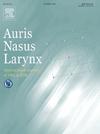Effects of simulated cochlear implant listening on postural control in typical-hearing adults
IF 1.5
4区 医学
Q2 OTORHINOLARYNGOLOGY
引用次数: 0
Abstract
Objective
Heightened listening effort in cochlear implant (CI) users may have a significant impact on their balance performance. This study aims to investigate the impact of listening effort on postural control in typical-hearing adults presented with CI-simulated speech in noise.
Methods
The study participants were fifty-eight adults with typical hearing (aged 20–24 years). Turkish Hearing in Noise Test (HINT) sentences were used as the speech material. The Modified Clinical Test of Sensory Interaction in Balance (mCTSIB) was used to evaluate static balance and it was performed by using Computerized Static Posturography. In the experimental design of the study, healthy participants with typical hearing listened to non-simulated and CI-simulated sentences and repeated what they heard while the participants were performing the mCTSIB test on the force platform of static posturography.
Results
In this study, the participants' postural sway velocity rates were compared under three task conditions. The results demonstrated a statistically significant increase in participants' sway velocity rates when listening to 12-channel filtered speech in noise material compared to those from the baseline mCTSIB assessment. There was no statistically significant differences in postural sway rate ratios when listening to unfiltered speech in noise material.
Conclusion
Increased listening effort for CI-simulated speech-in-noise resulted in poorer postural balance. A better understanding of such a difficulty may help us to evaluate postural balance from different perspectives and plan an appropriate vestibular rehabilitation program.
模拟人工耳蜗听力对正常听力成人体位控制的影响
目的人工耳蜗使用者提高听力努力程度可能对其平衡能力有显著影响。本研究旨在探讨正常听力成人在噪音环境下听听力努力对姿势控制的影响。方法研究对象为58名听力正常的成年人(年龄20 ~ 24岁)。语言材料采用土耳其语噪音听力测试(HINT)句子。采用计算机静态姿势照相技术,采用改良的平衡感觉相互作用临床测试(mCTSIB)来评估静态平衡。在本研究的实验设计中,听力正常的健康被试在静态姿势书写力平台上进行mCTSIB测试时,聆听非模拟和ci模拟句子并重复所听到的句子。结果本研究比较了三种任务条件下被试的姿态摇摆速度。结果显示,与mCTSIB基线评估相比,在噪声材料中听12通道过滤语音时,参与者的摇摆速度率在统计上显着增加。在听噪声材料中未过滤的语音时,姿势摇摆率比没有统计学上的显著差异。结论ci模拟噪声语音的听音努力增加导致姿势平衡较差。更好地了解这种困难可能有助于我们从不同的角度评估姿势平衡,并制定适当的前庭康复计划。
本文章由计算机程序翻译,如有差异,请以英文原文为准。
求助全文
约1分钟内获得全文
求助全文
来源期刊

Auris Nasus Larynx
医学-耳鼻喉科学
CiteScore
3.40
自引率
5.90%
发文量
169
审稿时长
30 days
期刊介绍:
The international journal Auris Nasus Larynx provides the opportunity for rapid, carefully reviewed publications concerning the fundamental and clinical aspects of otorhinolaryngology and related fields. This includes otology, neurotology, bronchoesophagology, laryngology, rhinology, allergology, head and neck medicine and oncologic surgery, maxillofacial and plastic surgery, audiology, speech science.
Original papers, short communications and original case reports can be submitted. Reviews on recent developments are invited regularly and Letters to the Editor commenting on papers or any aspect of Auris Nasus Larynx are welcomed.
Founded in 1973 and previously published by the Society for Promotion of International Otorhinolaryngology, the journal is now the official English-language journal of the Oto-Rhino-Laryngological Society of Japan, Inc. The aim of its new international Editorial Board is to make Auris Nasus Larynx an international forum for high quality research and clinical sciences.
 求助内容:
求助内容: 应助结果提醒方式:
应助结果提醒方式:


